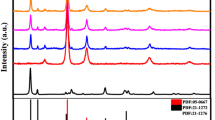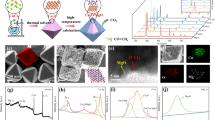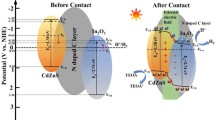Abstract
The reasonable employment of cocatalyst in photocatalysis can effectively promote the photocatalytic H2 production activity. In this study, carbon hollow spheres (C), as a good conductive nonmetallic material, have been utilized as a novel cocatalyst and a matrix for loading the Cu-doped-TiO2 nanoparticles by a successive hydrothermal method and metal molten salt method. The Cu-doped-TiO2 nanoparticles were tightly anchored on the surface of carbon hollow sphere to form a zero-dimensional/three dimensional (0D/3D) Cu-doped-TiO2/C heterojunction. The optimal Cu-doped-TiO2/C heterojunction demonstrated greatly enhanced photocatalytic H2 generation activity (14.4 mmol·g−1·h−1) compared with TiO2 (0.33 mmol·g−1·h−1) and TiO2/C (0.7 mmol·g−1·h−1). The performance improvement was mainly due to the synergistic effect of carbon hollow sphere cocatalyst and Cu-doping, the Cu-doping in TiO2 nanoparticles can minimize charge recombination and enhance the available photoexcited electrons, while the 3D carbon hollow spheres can act as electron traps to accelerate the charge separation and offer abundant active sites for solar water splitting reaction.
Graphical abstract

摘要
在光催化过程中合理地使用助催化剂可以有效地促进光催化产氢的活性。在本研究中, 通过水热法和金属熔盐法制备了一种以碳空心球 (C), 一种良好的导电非金属材料, 作为助催化剂及生长基体负载的Cu-掺杂的TiO2纳米颗粒新型光催化材料。铜掺杂TiO2纳米颗粒被紧密地固定在碳空心球的表面, 形成了0D/3D的Cu掺杂的TiO2/C异质结。与TiO2 (0.33 mmol·g-1·h-1) 和TiO2/C (0.7 mmol·g-1·h-1) 相比, 最佳的Cu掺杂的TiO2/C异质结显示出更好的光催化产氢活性 (14.4 mmol·g-1·h-1)。光催化性能提高主要归因于碳空心球体的助催化和Cu掺杂的协同作用, TiO2纳米颗粒中的Cu掺杂可以最大限度地减少电荷重组, 提高可用的光激发电子, 而三维碳空心球体可以作为电子陷阱, 加速电荷分离, 为太阳能水分离反应提供丰富的活性位点。










Similar content being viewed by others
References
Zhou SQ, Wang Y, Zhou K, Ba DY, Ao YH, Wang PF. In-situ construction of Z-scheme g-C3N4/WO3 composite with enhanced visible-light responsive performance for nitenpyram degradation. Chin Chem Lett. 2021;32(7):2179.
Zhang L, Xiao WP, Zhang Y, Han FY, Yang XF. Nanocarbon encapsulating Ni-doped MoP/graphene composites for highly improved electrocatalytic hydrogen evolution reaction. Compos Commun. 2021;26:100792.
Cao SW. Two-dimensional gersiloxenes with tunable band gap as new photocatalysts. Rare Met. 2020;39(6):610.
Shen R, Ren D, Ding Y, Guan Y, Ng YH, Zhang P, Li X. Nanostructured CdS for efficient photocatalytic H2 evolution: a review. Sci China Mater. 2020;63(11):2153.
Mu RH, Ao YH, Wu TF, Wang C, Wang PF. Synergistic effect of molybdenum nitride nanoparticles and nitrogen-doped carbon on enhanced photocatalytic hydrogen evolution performance of CdS nanorods. J Alloys Compd. 2020;812(5):151990.
Yang DX, Qu D, Miao X, Jiang WS, An L, Wen YJ, Wu DD, Sun ZC. TiO2 sensitized by red-, green-, blue-emissive carbon dots for enhanced H2 production. Rare Met. 2019;38(5):404.
Prasad C, Tang H, Liu QQ, Bahadur I, Karlapudi S, Jiang YJ. A latest overview on photocatalytic application of g-C3N4 based nanostructured materials for hydrogen production. Int J Hydrogen Energy. 2020;45(1):337.
Liu QQ, Huang JX, Wang LL, Yu XH, Sun JF, Tang H. Unraveling the roles of hot electrons and cocatalyst toward broad spectrum photocatalytic H2 generation of g-C3N4 nanotube. Solar RRL. 2020;5(6):2000504.
Yang XF, Liu W, Han CH, Zhao CX, Tang H, Liu QQ, Xu JS. Mechanistic insights into charge carrier dynamics in MoSe2/CdS heterojunctions for boosted photocatalytic hydrogen evolution. Mater Today Phys. 2020;15:100261.
Wang JF, Chen J, Wang PF, Hou J, Wang C, Ao YH. Robust photocatalytic hydrogen evolution over amorphous ruthenium phosphide quantum dots modified g-C3N4 nanosheet. Appl Catal B Environ. 2018;239(30):578.
She P, Rao H, Guan BY, Qin JS, Yu JH. Spatially separated bifunctional cocatalysts decorated on hollow-structured TiO2 for enhanced photocatalytic hydrogen generation. ACS Appl Mater Interfaces. 2020;12(20):23356.
Wang P, Li HT, Cao YJ, Yu HG. Carboxyl-functionalized graphene for highly efficient H2-evolution activity of TiO2 photocatalyst. Acta Phys -Chim Sin. 2021;37:2008047.
Mu RH, Ao YH, Wu TF, Wang C, Wang P. Synthesis of novel ternary heterogeneous anatase-TiO2 (B) biphase nanowires/Bi4O5I2 composite photocatalysts for the highly efficient degradation of acetaminophen under visible light irradiation. J Hazard Mater. 2020;382(15):121083.
Xu FY, Tan HY, Fan JJ, Cheng B, Yu JG, Xu JS. Electrospun TiO2-based photocatalysts. Solar RRL. 2021;5(6):2000571.
Zhang QH, Gao L. Preparation of oxide nanocrystals with tunable morphologies by the moderate hydrothermal method: insights from rutile TiO2. Langmuir. 2003;19(3):967.
Peng WD, Yang C, Yu J. Bi2O3 and g-C3N4 quantum dot modified anatase TiO2 heterojunction system for degradation of dyes under sunlight irradiation. RSC Adv. 2020;10(2):1181.
Lu Y, Fan DQ, Wang YD, Xu HL, Lu CH, Yang XF. Surface patterning of two-dimensional nanostructure-embedded photothermal hydrogels for high-yield solar steam generation. ACS Nano. 2021;15(6):10366.
Wang R, Shen J, Zhang WJ, Liu QQ, Zhang MY, Zulfiqar TH. Build-in electric field induced step-scheme TiO2/W18O49 heterojunction for enhanced photocatalytic activity under visible-light irradiation. Ceram Int. 2020;46(1):23.
Ao YH, Xu LY, Wang PF, Wang C, Hou J, Qian J. Preparation of CdS nanoparticle loaded flower-like Bi2O2CO3 heterojunction photocatalysts with enhanced visible light photocatalytic activity. Dalton Trans. 2015;44(25):11321.
Xie JJ, Hao X, Su BL, Cheng YB, Du XD, Zeng H, Wang MH, Wang WM, Wang H, Fu ZY. Mussel-directed synthesis of nitrogen-doped anatase TiO2. Angew Chem Int Ed. 2016;55(9):3031.
Zhong W, Wu XH, Liu YP, Wang XF, Fan JJ, Yu HG. Simultaneous realization of sulfur-rich surface and amorphous nanocluster of NiS1+x cocatalyst for efficient photocatalytic H2 evolution. Appl Catal B. 2021;280:119455.
Low JX, Dai BZ, Tong T, Jiang CJ, Yu JG. In situ irradiated X-ray photoelectron spectroscopy investigation on a direct Z-scheme TiO2/CdS composite film photocatalyst. Adv Mater. 2019;31(6):1802981.
Wang LL, Tang GG, Liu S, Dong HL, Liu QQ, Sun JF, Tang H. Interfacial active-site-rich 0D Co3O4/1D TiO2 p-n heterojunction for enhanced photocatalytic hydrogen evolution. Chem Eng J. 2021;428(15):131338.
Reddy NR, Bharagav U, Kumari MM, Cheralathan KK, Ojha PK, Shankar MV, Joo SW. Inclusion of low cost activated carbon for improving hydrogen production performance of TiO2 nanoparticles under natural solar light irradiation. Ceram Int. 2021;47(7):10216.
Ahmed AM, Mohamed F, Ashraf AM, Shaban M, Khan AAP, Asiri AM. Enhanced photoelectrochemical water splitting activity of carbon nanotubes@TiO2 nanoribbons in different electrolytes. Chemosphere. 2020;238:124554.
Wang J, Wang GH, Jiang J, Wan Z, Su YR, Tang H. Insight into charge carrier separation and solar-light utilization: rGO decorated 3D ZnO hollow microspheres for enhanced photocatalytic hydrogen evolution. J Colloid Interface Sci. 2020;564(22):322.
Li N, Qin BH, Kang HF, Cai NN, Huang SP, Xiao Q. Engineering hollow carbon spheres: directly from solid resin spheres to porous hollow carbon spheres via air induced linker cleaving. Nanoscale. 2021;13(32):13873.
Zhu CZ, Chen X, Ma J, Gu C, Xian QM, Gong TT, Sun C. Carbon nitride-modified defective TiO2–x@carbon spheres for photocatalytic H2 evolution and pollutants removal: synergistic effect and mechanism insight. J Phys Chem C. 2018;122(35):20444.
Peng JJ, Shen J, Yu XH, Tang H, Zulfiqar LQQ. Construction of LSPR-enhanced 0D/2D CdS/MoO3-x S-scheme heterojunctions for visible-light-driven photocatalytic H2 evolution. Chin J Catal. 2021;42(1):87.
Xu HT, Xiao R, Huang JR, Jiang Y, Zhao CX, Yang XF. In situ construction of protonated g-C3N4/Ti3C2 MXene schottky heterojunctions for efficient photocatalytic hydrogen production. Chin J Catal. 2021;42(1):107.
Li KY, Chen J, Ao YH, Wang PF. Preparation of a ternary g-C3N4-CdS/Bi4O5I2 composite photocatalysts with two charge transfer pathways for efficient degradation of acetaminophen under visible light irradiation. Sep Purif Technol. 2021;259(15):118177.
Jiang Z, Chen Q, Zheng Q, Shen R, Zhang P, Li X. Constructing 1D/2D schottky-based heterojunctions between Mn0.2Cd0.8S nanorods and Ti3C2 nanosheets for boosted photocatalytic H2 evolution. Acta Phys Chim Sin. 2021;37:2010059.
Gao DD, Yuan RR, Fan JJ, Hong XK, Yu HG. Highly efficient S2-adsorbed MoSx-modified TiO2 photocatalysts: a general grafting strategy and boosted interfacial charge transfer. J Mater Sci Technol. 2020;56(1):122.
Liu QQ, Huang JX, Tang H, Yu XH, Shen J. Construction 0D TiO2 nanoparticles/2D CoP nanosheets heterojunctions for enhanced photocatalytic H2 evolution activity. J Mater Sci Technol. 2020;56(1):196.
Jaiswal R, Bharambe J, Patel N, Dashora A, Kothari DC, Miotello A. Copper and nitrogen co-doped TiO2 photocatalyst with enhanced optical absorption and catalytic activity. Appl Catal B Environ. 2015;168:333.
Valero JM, Obregón S, Colón G. Active site considerations on the photocatalytic H2 evolution performance of Cu-doped TiO2 obtained by different doping methods. ACS Catal. 2014;4(10):3320.
Zhang J, Fu J, Chen S, Lv JL, Dai K. 1D carbon nanofibers@TiO2 core-shell nanocomposites with enhanced photocatalytic activity toward CO2 reduction. J Alloys Compd. 2018;746(25):168.
Dou YB, Zhang ST, Pan T, Xu SM, Zhou A, Pu M, Yan H, Han JB, Wei M, Evans DG, Duan X. TiO2@layered double hydroxide core-shell nanospheres with largely enhanced photocatalytic activity toward O2 generation. Adv Funct Mater. 2015;25(15):2243.
Liu C, Dong SS, Chen YG. Enhancement of visible-light-driven photocatalytic activity of carbon plane/g-C3N4/TiO2 nanocomposite by improving heterojunction contact. Chem Eng J. 2019;371(1):706.
Zong HX, Zhao T, Zhou GD, Qian RF, Feng T, Pan JH. Revisiting structural and photocatalytic properties of g-C3N4/TiO2: is surface modification of TiO2 by calcination with urea an effective route to “solar” photocatalyst? Catal. Today. 2019;335(1):252.
Ren MM, Xu H, Li F, Liu WL, Gao CL, Su LW, Li GD, Hei JP. Sugarapple-like N-doped TiO2@carbon core-shell spheres as high-rate and long-life anode materials for lithium-ion batteries. J Power Sources. 2017;353(15):237.
Abdel-Mageed AM, Rungtaweevoranit B, Parlinska-Wojtan M, Pei XK, Yaghi OM, Behm RJ. Highly active and stable single-atom Cu catalysts supported by a metal-organic framework. J Am Chem Soc. 2019;141(13):5201.
Zhao J, Shi R, Li ZH, Zhou C, Zhang TR. How to make use of methanol in green catalytic hydrogen production? Nano Select. 2020;1(1):12.
Acknowledgements
This work was financially supported by the National Natural Science Foundation of China (Nos. 21975110 and 21972058) and Prof. Hua Tang thanks Taishan Youth Scholar Program of Shandong Province.
Author information
Authors and Affiliations
Corresponding authors
Ethics declarations
Conflict of interests
The authors declare that they have no conflict of interest.
Supplementary Information
Below is the link to the electronic supplementary material.
Rights and permissions
About this article
Cite this article
Sun, LJ., Su, HW., Xu, DF. et al. Carbon hollow spheres as cocatalyst of Cu-doped TiO2 nanoparticles for improved photocatalytic H2 generation. Rare Met. 41, 2063–2073 (2022). https://doi.org/10.1007/s12598-021-01936-5
Received:
Revised:
Accepted:
Published:
Issue Date:
DOI: https://doi.org/10.1007/s12598-021-01936-5




